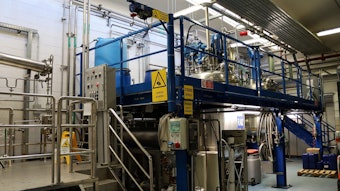Global sourcing is driven by far more than a search for low cost. It is a long-term systemic trend that necessitates a completely new thought process to structure supply chains from the ground up. Architecting a supply chain for today’s sourcing requires a quantum leap from past shipping practices. The supply chain paradigm is dramatically changing, and the most successful companies integrate constant awareness of those changes into their strategic planning process.
The transformation of global sourcing, transportation and distribution networks has stretched the resources of all but the largest multinational corporations. Demanding service levels and high costs (for everything from fuel to regulatory compliance) make supply chain management a top priority in the tough competitive conditions that beauty companies face. Producers that have made cutbacks in their own organizations to reduce costs may lack adequate logistics infrastructure, capable decision support tools, necessary capital and operating scale.
Planning and Preparation
In the world of global sourcing, speed depends on planning and preparation. Inadequate preparation, reflecting incomplete information about supplier and carrier reliability, as well as customs and shipping requirements, is the most preventable and most costly problem when it comes to inefficiencies in global sourcing. Advance planning for all the contingencies that impact global sourcing—customs and security regimes, sustainability concerns, technology requirements, contract terms and more—is essential. No longer can the logistics process be an afterthought.
The industry must realize that advance planning and information control are essential to creating an efficient global supply chain accurate and instantaneous information supports efficient global logistics. Through structured logistics system development and sophisticated electronic tracking, an efficient supply chain will use cutting-edge electronic systems for sourcing that improves both fuel efficiency and cost effectiveness, because it eliminates the guesswork and backtracking to find misplaced shipments and affords maximum flexibility in route and load planning. By taking these factors into account from the start of logistics integration, there is saving in fuel, energy, resources and time.
There is much discussion today about green or sustainable global supply chains. Sustainability, efficiency and cost-effectiveness are virtually synonymous when it comes to global supply chain planning. The key factors that shape today’ global supply chain processes, and thus global logistics costs, has demonstrated that proposition. Customs, security, technology and processing concerns all have been transformed in less than a decade. The company that is not transforming its global sourcing logistics processes to accommodate them will have a dysfunctional sourcing and shipping effort that is a competitive disadvantage.
The global supply chain is already embedded in the economies of most countries. Companies that don’t want to make a conscious global supply decision will find that marketplace forces make it for them. When producers and logistics specialists work together in an integrated process founded on initial logistics planning, it facilitates the movement of products around the globe, quickly, cleanly and without loss, creating a supply chain with a minimal amount of inefficiency and maximum amount of flexibility.
Industry Insight
An efficient global supply chain requires detailed familiarity with each shipper’s industry requirements and practices, in addition to understanding the associated service parameters and costs. When it comes to challenges such as throughput, security, customs and other regulations, and product tracking, industry insight is essential. Logistics companies, until recently, have largely emphasized general freight forwarding experience. Supply chain management, by contrast, requires in-depth logistics and purchasing knowledge as it relates to an industry itself, creating a value proposition directly focused on the industry’s freight requirements.
With global sales of more than $300 billion, beauty presents one of the most complex global freight forwarding challenges of any industry. What is needed for global sourcing success is not just supply chain management, it is in-depth logistics and purchasing knowledge as it relates to the global beauty industry itself. Complete and timely delivery is the ultimate measurement of service and reliability, and this is synonymous with an integrated transport management system that coordinates every phase of the process—from contractual activity, to delivery and cost finalizations.
Transporting either raw materials or finished product is a complex process and one that requires precise integration. From transport contracting to trip closure, with storage and shipment in between, an interactive transport management system will have action points where performance is measured and documented. With transportation systems that allow for "vetting" interactions for the smooth flow of clearance data from one operational activity to the next, a global supply chain becomes fully transparent and operationally efficient. It transcends past decades of fragmented processes and brings predictability and consistency to logistics performance.
Simon Kaye is founder and CEO of Jaguar Freight Services, with operations and fully integrated door-to-door freight solution networks in Europe, North America, South America, Australasia, Asia, the Middle East and Africa. [email protected]; www.jaguarfreight.com; 1-516-239-1900










